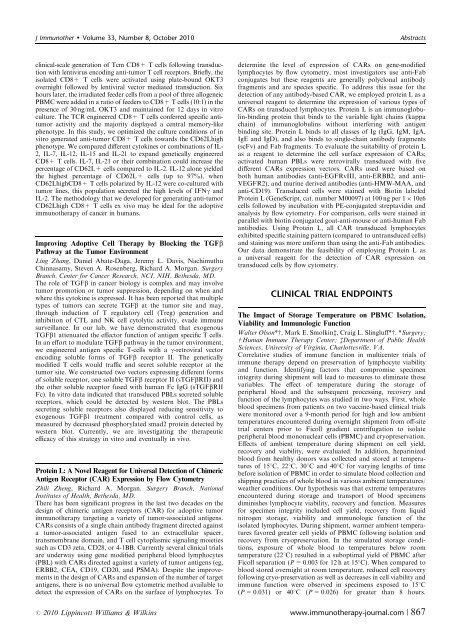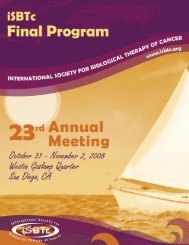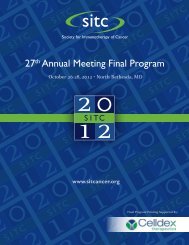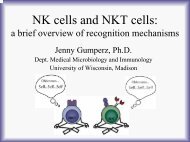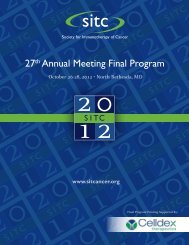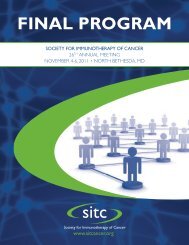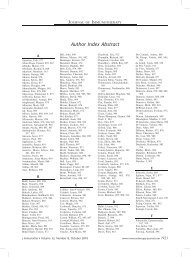Abstracts for the 25th Annual Scientific Meeting of the International ...
Abstracts for the 25th Annual Scientific Meeting of the International ...
Abstracts for the 25th Annual Scientific Meeting of the International ...
You also want an ePaper? Increase the reach of your titles
YUMPU automatically turns print PDFs into web optimized ePapers that Google loves.
J Immuno<strong>the</strong>r Volume 33, Number 8, October 2010<br />
<strong>Abstracts</strong><br />
clinical-scale generation <strong>of</strong> Tcm CD8+ T cells following transduction<br />
with lentivirus encoding anti-tumor T cell receptors. Briefly, <strong>the</strong><br />
isolated CD8+ T cells were activated using plate-bound OKT3<br />
overnight followed by lentiviral vector mediated transduction. Six<br />
hours later, <strong>the</strong> irradiated feeder cells from a pool <strong>of</strong> three allogeneic<br />
PBMC were added in a ratio <strong>of</strong> feeders to CD8+ T cells (10:1) in <strong>the</strong><br />
presence <strong>of</strong> 30 ng/mL OKT3 and maintained <strong>for</strong> 12 days in vitro<br />
culture. The TCR engineered CD8+ T cells conferred specific antitumor<br />
activity and <strong>the</strong> majority displayed a central memory-like<br />
phenotype. In this study, we optimized <strong>the</strong> culture conditions <strong>of</strong> in<br />
vitro generated anti-tumor CD8+ T cells towards <strong>the</strong> CD62Lhigh<br />
phenotype. We compared different cytokines or combinations <strong>of</strong> IL-<br />
2, IL-7, IL-12, IL-15 and IL-21 to expand genetically engineered<br />
CD8+ T cells. IL-7, IL-21 or <strong>the</strong>ir combination could increase <strong>the</strong><br />
percentage <strong>of</strong> CD62L+ cells compared to IL-2. IL-12 alone yielded<br />
<strong>the</strong> highest percentage <strong>of</strong> CD62L+ cells (up to 97%), when<br />
CD62LhighCD8+ T cells polarized by IL-12 were co-cultured with<br />
tumor lines, this population secreted <strong>the</strong> high levels <strong>of</strong> IFNg and<br />
IL-2. The methodology that we developed <strong>for</strong> generating anti-tumor<br />
CD62Lhigh CD8+ T cells ex vivo may be ideal <strong>for</strong> <strong>the</strong> adoptive<br />
immuno<strong>the</strong>rapy <strong>of</strong> cancer in humans.<br />
Improving Adoptive Cell Therapy by Blocking <strong>the</strong> TGFb<br />
Pathway at <strong>the</strong> Tumor Environment<br />
Ling Zhang, Daniel Abate-Daga, Jeremy L. Davis, Nachimuthu<br />
Chinnasamy, Steven A. Rosenberg, Richard A. Morgan. Surgery<br />
Branch, Center <strong>for</strong> Cancer Research, NCI, NIH, Be<strong>the</strong>sda, MD.<br />
The role <strong>of</strong> TGFb in cancer biology is complex and may involve<br />
tumor promotion or tumor suppression, depending on when and<br />
where this cytokine is expressed. It has been reported that multiple<br />
types <strong>of</strong> tumors can secrete TGFb at <strong>the</strong> tumor site and may,<br />
through induction <strong>of</strong> T regulatory cell (Treg) generation and<br />
inhibition <strong>of</strong> CTL and NK cell cytolytic activity, evade immune<br />
surveillance. In our lab, we have demonstrated that exogenous<br />
TGFb1 attenuated <strong>the</strong> effector function <strong>of</strong> antigen specific T cells.<br />
In an ef<strong>for</strong>t to modulate TGFb pathway in <strong>the</strong> tumor environment,<br />
we engineered antigen specific T-cells with a g-retroviral vector<br />
encoding soluble <strong>for</strong>ms <strong>of</strong> TGFb receptor II. The genetically<br />
modified T cells would traffic and secret soluble receptor at <strong>the</strong><br />
tumor site. We constructed two vectors expressing different <strong>for</strong>ms<br />
<strong>of</strong> soluble receptor, one soluble TGFb receptor II (sTGFbRII) and<br />
<strong>the</strong> o<strong>the</strong>r soluble receptor fused with human Fc IgG (sTGFbRII<br />
Fc). In vitro data indicated that transduced PBLs secreted soluble<br />
receptors, which could be detected by western blot. The PBLs<br />
secreting soluble receptors also displayed reducing sensitivity to<br />
exogenous TGFb1 treatment compared with control cells, as<br />
measured by decreased phosphorylated smad2 protein detected by<br />
western blot. Currently, we are investigating <strong>the</strong> <strong>the</strong>rapeutic<br />
efficacy <strong>of</strong> this strategy in vitro and eventually in vivo.<br />
Protein L: A Novel Reagent <strong>for</strong> Universal Detection <strong>of</strong> Chimeric<br />
Antigen Receptor (CAR) Expression by Flow Cytometry<br />
Zhili Zheng, Richard A. Morgan. Surgery Branch, National<br />
Institutes <strong>of</strong> Health, Be<strong>the</strong>sda, MD.<br />
There has been significant progress in <strong>the</strong> last two decades on <strong>the</strong><br />
design <strong>of</strong> chimeric antigen receptors (CAR) <strong>for</strong> adoptive tumor<br />
immuno<strong>the</strong>rapy targeting a variety <strong>of</strong> tumor-associated antigens.<br />
CARs consists <strong>of</strong> a single chain antibody fragment directed against<br />
a tumor-associated antigen fused to an extracellular spacer,<br />
transmembrane domain, and T cell cytoplasmic signaling moieties<br />
such as CD3 zeta, CD28, or 4-1BB. Currently several clinical trials<br />
are underway using gene modified peripheral blood lymphocytes<br />
(PBL) with CARs directed against a variety <strong>of</strong> tumor antigens (eg,<br />
ERBB2, CEA, CD19, CD20, and PSMA). Despite <strong>the</strong> improvements<br />
in <strong>the</strong> design <strong>of</strong> CARs and expansion <strong>of</strong> <strong>the</strong> number <strong>of</strong> target<br />
antigens, <strong>the</strong>re is no universal flow cytometric method available to<br />
detect <strong>the</strong> expression <strong>of</strong> CARs on <strong>the</strong> surface <strong>of</strong> lymphocytes. To<br />
determine <strong>the</strong> level <strong>of</strong> expression <strong>of</strong> CARs on gene-modified<br />
lymphocytes by flow cytometry, most investigators use anti-Fab<br />
conjugates but <strong>the</strong>se reagents are generally polyclonal antibody<br />
fragments and are species specific. To address this issue <strong>for</strong> <strong>the</strong><br />
detection <strong>of</strong> any antibody-based CAR, we employed protein L as a<br />
universal reagent to determine <strong>the</strong> expression <strong>of</strong> various types <strong>of</strong><br />
CARs on transduced lymphocytes. Protein L is an immunoglobulin-binding<br />
protein that binds to <strong>the</strong> variable light chains (kappa<br />
chain) <strong>of</strong> immunoglobulins without interfering with antigen<br />
binding site. Protein L binds to all classes <strong>of</strong> Ig (IgG, IgM, IgA,<br />
IgE and IgD), and also binds to single-chain antibody fragments<br />
(scFv) and Fab fragments. To evaluate <strong>the</strong> suitability <strong>of</strong> protein L<br />
as a reagent to determine <strong>the</strong> cell surface expression <strong>of</strong> CARs;<br />
activated human PBLs were retrovirally transduced with five<br />
different CARs expression vectors. CARs used were based on<br />
both human antibodies (anti-EGFRvIII, anti-ERBB2, and anti-<br />
VEGFR2), and murine derived antibodies (anti-HMW-MAA, and<br />
anti-CD19). Transduced cells were stained with Biotin labeled<br />
Protein L (GeneScript, cat. number M00097) at 100 ng per 1 10e6<br />
cells followed by incubation with PE-conjugated streptavidin and<br />
analysis by flow cytometry. For comparison, cells were stained in<br />
parallel with biotin conjugated goat-anti-mouse or anti-human Fab<br />
antibodies. Using Protein L, all CAR transduced lymphocytes<br />
exhibited specific staining pattern (compared to untransduced cells)<br />
and staining was more uni<strong>for</strong>m than using <strong>the</strong> anti-Fab antibodies.<br />
Our data demonstrate <strong>the</strong> feasibility <strong>of</strong> employing Protein L as<br />
a universal reagent <strong>for</strong> <strong>the</strong> detection <strong>of</strong> CAR expression on<br />
transduced cells by flow cytometry.<br />
CLINICAL TRIAL ENDPOINTS<br />
The Impact <strong>of</strong> Storage Temperature on PBMC Isolation,<br />
Viability and Immunologic Function<br />
Walter Olson*w, Mark E. Smolkinz, Craig L. Slingluff*w. *Surgery;<br />
w Human Immune Therapy Center; zDepartment <strong>of</strong> Public Health<br />
Sciences, University <strong>of</strong> Virginia, Charlottesville, VA.<br />
Correlative studies <strong>of</strong> immune function in multicenter trials <strong>of</strong><br />
immune <strong>the</strong>rapy depend on preservation <strong>of</strong> lymphocyte viability<br />
and function. Identifying factors that compromise specimen<br />
integrity during shipment will lead to measures to eliminate those<br />
variables. The effect <strong>of</strong> temperature during <strong>the</strong> storage <strong>of</strong><br />
peripheral blood and <strong>the</strong> subsequent processing, recovery and<br />
function <strong>of</strong> <strong>the</strong> lymphocytes was studied in two ways. First, whole<br />
blood specimens from patients on two vaccine-based clinical trials<br />
were monitored over a 9-month period <strong>for</strong> high and low ambient<br />
temperatures encountered during overnight shipment from <strong>of</strong>f-site<br />
trial centers prior to Ficoll gradient centrifugation to isolate<br />
peripheral blood mononuclear cells (PBMC) and cryopreservation.<br />
Effects <strong>of</strong> ambient temperature during shipment on cell yield,<br />
recovery and viability, were evaluated. In addition, heparinized<br />
blood from healthy donors was collected and stored at temperatures<br />
<strong>of</strong> 151C, 221C, 301C and 401C <strong>for</strong> varying lengths <strong>of</strong> time<br />
be<strong>for</strong>e isolation <strong>of</strong> PBMC in order to simulate blood collection and<br />
shipping practices <strong>of</strong> whole blood in various ambient temperatures/<br />
wea<strong>the</strong>r conditions. Our hypo<strong>the</strong>sis was that extreme temperatures<br />
encountered during storage and transport <strong>of</strong> blood specimens<br />
diminishes lymphocyte viability, recovery and function. Measures<br />
<strong>for</strong> specimen integrity included cell yield, recovery from liquid<br />
nitrogen storage, viability and immunologic function <strong>of</strong> <strong>the</strong><br />
isolated lymphocytes. During shipment, warmer ambient temperatures<br />
favored greater cell yields <strong>of</strong> PBMC following isolation and<br />
recovery from cryopreservation. In <strong>the</strong> simulated storage conditions,<br />
exposure <strong>of</strong> whole blood to temperatures below room<br />
temperature (221C) resulted in a suboptimal yield <strong>of</strong> PBMC after<br />
Ficoll separation (P = 0.003 <strong>for</strong> 12 h at 151C). When compared to<br />
blood stored overnight at room temperature, reduced cell recovery<br />
following cryo-preservation as well as decreases in cell viability and<br />
immune function were observed in specimens exposed to 151C<br />
(P = 0.031) or 401C (P = 0.026) <strong>for</strong> greater than 8 hours.<br />
r 2010 Lippincott Williams & Wilkins www.immuno<strong>the</strong>rapy-journal.com | 867


